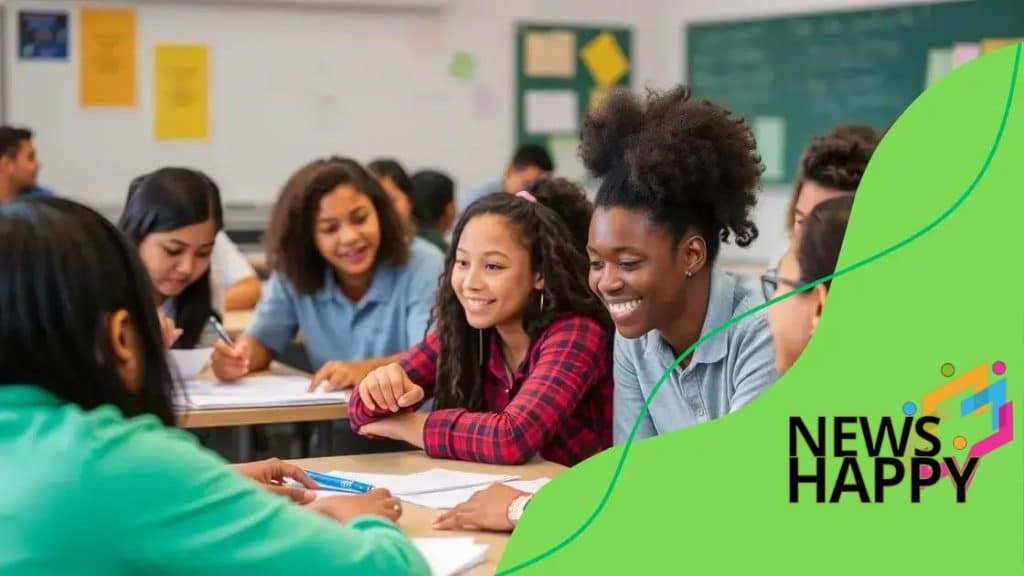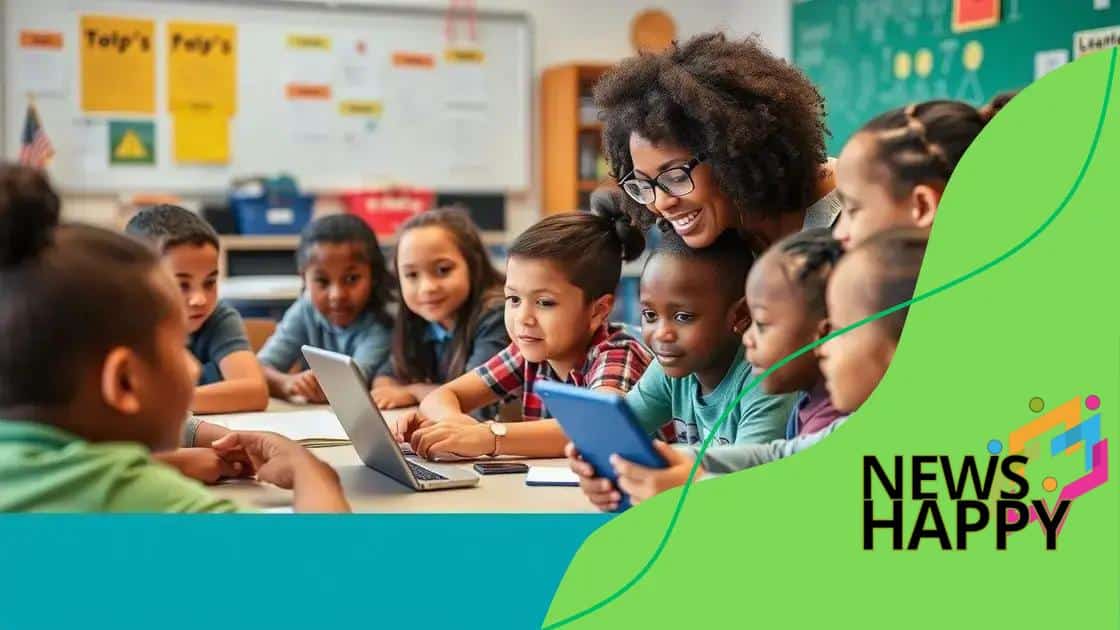The importance of inclusive education for diverse student populations

Anúncios
The importance of inclusive education for diverse student populations lies in fostering understanding, promoting collaboration, and ensuring that every student, regardless of background or ability, can thrive academically and socially in a supportive environment.
The importance of inclusive education for diverse student populations cannot be overstated. It shapes learning opportunities and fosters empathy among students. Have you considered how inclusive practices could transform your classroom?
Anúncios
Understanding inclusive education
Understanding inclusive education is crucial for creating equal learning opportunities in our schools. It means making sure every student, regardless of their background or abilities, can learn together in a supportive environment.
In an inclusive classroom, teachers adapt their methods to meet the diverse needs of all students. This approach helps everyone achieve their potential.
Key Principles of Inclusive Education
There are some key principles that guide inclusive education. These are essential for fostering a welcoming atmosphere:
Anúncios
- Respect for all learners’ rights.
- Support for diverse learning styles.
- Collaboration among teachers, families, and communities.
Another important aspect is the need for training and resources for teachers. They must be equipped with the tools to implement inclusive practices effectively. This could include workshops on understanding various disabilities or strategies for engaging with parents.
Benefits of Inclusive Education
When schools embrace inclusive education, everyone benefits. Here are a few ways:
- Students learn to appreciate diversity.
- Improved academic outcomes for all students.
- Better social skills through peer interactions.
Furthermore, inclusive education promotes a sense of belonging. When students feel accepted, they are more likely to participate actively in their learning journey. However, achieving true inclusivity requires dedication and commitment from all stakeholders.
By understanding the elements of inclusive education, schools can create an environment where every student thrives, preparing them for a diverse world beyond the classroom.
Benefits of inclusion for students
One of the most important aspects of inclusive education is the numerous benefits it offers to students. These advantages can extend beyond academic success to personal growth and social development.
By participating in inclusive classrooms, students gain a better understanding of diversity. They learn from each other, fostering an environment of empathy and respect. This experience helps students build strong relationships with their peers, regardless of differences.
Academic Growth
Research shows that inclusive education can lead to improved academic outcomes. When students learn together, they can benefit from peer tutoring and support. Understanding different perspectives also enriches discussions, making learning more engaging.
- Increased motivation to participate.
- Access to a wider range of resources.
- Enhanced problem-solving skills.
Moreover, inclusive classrooms often promote higher expectations from both teachers and students. When everyone is held to the same standard, it can encourage all students to reach their full potential.
Social Skills Development
Aside from academics, inclusion plays a vital role in developing important social skills. Students learn how to communicate effectively with others, navigate conflicts, and work as a team. These interactions are crucial for building friendships.
- Understanding and accepting differences.
- Improved communication and collaboration.
- Better conflict resolution skills.
As they work together, students acquire life skills that will benefit them long after they leave school. By creating a culture of inclusivity, schools empower students with the tools they need to thrive in a diverse society.
Strategies for implementing inclusive practices

Implementing inclusive practices in education requires thoughtful strategies that help accommodate all learners. These methods create a positive learning environment where everyone can succeed.
One essential strategy is to create a supportive classroom culture. This involves encouraging respect and understanding among students. A safe space allows all voices to be heard and valued. Teachers can promote this by facilitating group discussions and team projects.
Adapting Teaching Methods
Another effective approach is to adapt teaching methods to meet diverse needs. This includes using various instructional techniques, such as:
- Visual aids to support visual learners.
- Hands-on activities for kinesthetic learners.
- Group work to encourage collaborative learning.
By presenting information in different ways, teachers can engage every student, making content more accessible and understandable.
Using Technology
Incorporating technology in the classroom can also enhance inclusive education. Tools such as educational apps and online resources allow students to learn at their own pace. These platforms often offer adjustable settings to accommodate different learning styles. For example, students can listen to audio versions of texts or use interactive games to reinforce concepts.
Regular training for teachers on inclusive practices is vital. Ongoing professional development helps educators stay informed about new strategies and tools. It also ensures that teachers feel confident in their ability to support all students.
Overall, fostering an inclusive environment requires commitment and creativity. By embracing diverse teaching strategies and utilizing technology, schools can empower all students to thrive.
Challenges in achieving true inclusivity
Achieving true inclusivity in education presents several challenges. Despite the growing awareness of its importance, many schools face barriers that hinder effective implementation.
One major challenge is the lack of resources. Schools may not have access to specialized training for teachers or appropriate materials to support diverse learners. This lack of support can lead to inconsistent practices and limited understanding of inclusivity.
Attitudinal Barriers
Another significant hurdle is the existence of attitudinal barriers. Some educators and administrators may hold misconceptions about students with disabilities or different learning needs. These attitudes can lead to lower expectations and less support for those students.
- Beliefs that certain students cannot learn effectively.
- Resistance to changing traditional teaching methods.
- Lack of prioritization for inclusivity in school policies.
Additionally, large class sizes can pose another obstacle. Teachers may struggle to give individual attention when they have too many students. This may prevent them from understanding and addressing each student’s unique needs. Furthermore, high teacher turnover can disrupt the continuity of inclusive practices.
Curriculum Limitations
Curricula that are not designed with inclusivity in mind can also create barriers to learning. Many educational materials do not reflect diverse perspectives or learning styles. This can alienate students who do not see themselves represented in the content.
Overcoming these challenges requires a concerted effort from all stakeholders. Schools need to prioritize training, resource allocation, and curriculum development that embraces inclusivity. By addressing these barriers, educational institutions can create environments where every student can thrive.
The role of teachers in inclusive education
The role of teachers in inclusive education is pivotal. They are the ones who create a welcoming atmosphere where all students feel valued and supported. Teachers must adapt their teaching methods to meet the diverse needs of their learners.
One effective strategy is for teachers to use differentiated instruction. This means providing different avenues for students to explore and learn, depending on their individual strengths and challenges. For example, a teacher might offer visual aids for visual learners and hands-on activities for kinesthetic learners.
Building Relationships
Strong relationships between teachers and students contribute to a successful inclusive environment. When teachers take the time to get to know their students, they can better understand their needs and motivations. Building trust allows students to feel safe to express themselves and ask for help when needed.
- Encouraging open communication.
- Providing constructive feedback.
- Being available for support after class.
Teachers also play a crucial role in fostering a sense of community among students. By promoting teamwork and collaboration, educators help classmates learn from one another’s unique perspectives. This not only enhances learning but also builds friendships among students.
Professional Development
Continuous learning for teachers is essential to providing effective inclusive education. Professional development opportunities allow teachers to stay updated on best practices and innovative strategies. Workshops, conferences, and peer collaborations help them improve their skills and adapt to new challenges.
Moreover, teachers should work closely with specialists, such as special education professionals and counselors. Collaborating with these experts enriches the knowledge base and ensures that teachers have adequate support to meet every student’s needs.
Ultimately, teachers are the key to unlocking the potential of all students in an inclusive classroom. Their commitment to embracing diversity fosters an environment where every student can succeed.
FAQ – Frequently Asked Questions about Inclusive Education
What is inclusive education?
Inclusive education is an approach that ensures all students, regardless of their abilities or backgrounds, learn together in a supportive environment.
How can teachers support inclusive practices in the classroom?
Teachers can support inclusivity by adapting their teaching methods, creating a welcoming atmosphere, and building strong relationships with each student.
What are some common challenges to achieving inclusivity?
Common challenges include a lack of resources, attitudinal barriers, and large class sizes which can hinder personalized attention for students.
Why is inclusivity important for students?
Inclusivity promotes understanding, empathy, and social skills among students, contributing to their overall personal and academic growth.





